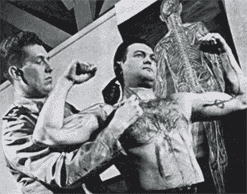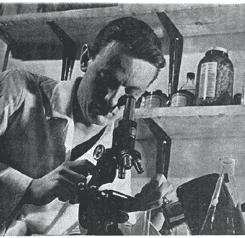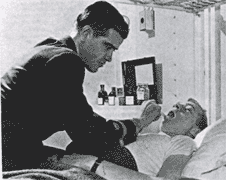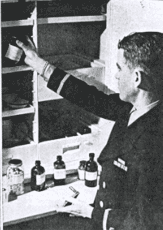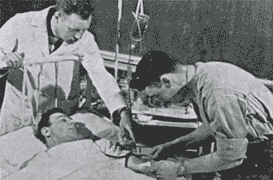Hospital Corpsmen: U.S. Maritime Service trains Pursers for combination medical-paper work on ships
Mast Magazine, May 1944
Steamship companies are now putting on board their vessels combination Purser-Hospital Corpsmen, also referred to as Pharmacist Mates, to handle both the paper work and sick bay treatment, the latter being an innovation in the shipping business and one that is fast making our seamen the best cared for of any merchant mariners in the world.
The time was not far distant when first aid was given in a rather vague manner and medicines dispensed with the nonchalance associated with a drug store clerk whipping up an ice cream soda. One old skipper, the story goes, had his bottles of drugs and medicines numbered, using No. 1 for colds, No. 2 for sprains, etc. A deck hand came to him for treatment one day and the skipper analyzed the case and reached for bottle No. 11. But, alas! Bottle No. 11 was empty. This didn't discourage the captain. He poured half of No. 5 and half of No. 6 into the empty bottle and carried on.
The story, a little distorted perhaps, illustrates a point. Before the war, there were no competent, trained members of the crew who could administer first aid properly on most of our ships. But the exigencies of war brought about the change. Merchant ships, active in all battle areas, had injured men on board who needed medical attention -- and the number was increasing.
Casualties among Merchant Seamen, in comparison to Navy casualties, were at the ratio of four to one at the beginning of the war. The problem of finding trained medical men was also a tough job. Professional men had been taken into the armed forces at an astounding rate. The idea of putting an extra man on board to handle the job alone also didn't seem reasonable. It was therefore decided to combine the position with that of the Purser, who could take four months of training and return to sea in his new role.
Founding of Hospital Corps School at the Sheepshead Bay
The Maritime Service began, on December 7, 1942, a Hospital Corps School at the Sheepshead Bay training station with Surgeon S. S. Heilwell (R), U. S. Public Health Service, in charge. Of the original class of 331 students, 239 were graduated on March 12, 1943.Quota for the school was soon increased to 600 students, 50 to be admitted weekly from the training stations after careful scrutiny by examining boards. The Junior Assistant Purser School and the Hospital Corps Schools were combined according to an official directive dated March 29, 1943. The first Pursers who left sea duty to attend the school came aboard the station August 10, 1943. By January 1, 1944, there were 600 combination men at sea; the school had graduated 1,324 men up to this time.
The program itself is unique in many respects and has acquired the attentive and inquisitive eye of other branches of the service. Men are trained primarily for independent duty as Hospital Corpsmen on transports, tankers and freighters, whereas Army and Navy men occupying similar roles are assistants to the medical officer on board.
Skills and Duties of Purser-Hospital Corpsman
Every Purser-Hospital Corpsman is trained to act alone, to rely on his own knowledge and experience to handle every situation that arises on the ship. He is responsible only to the Captain and is the health, hygiene and sanitation authority for his vessel.Dr. Heilwell underlines the point that these men are not doctors when they complete the course. However, they are skilled and competent to treat wounds, administer first aid and treat the ordinary ailments of seamen, keep up the sanitation standards of the vessel, help to prevent epidemics and the spread of diseases from one port to another, and apply the latest medical methods and drugs (the sulfa family and penicillin) to ailing crew members.
Future Hospital Corpsman learns anatomyTo give these men the essential knowledge to fulfill this tremendous responsibility, the Hospital Corps School has designed a program of study which includes courses in Pharmacy, clinical laboratory, hygiene and sanitation, emergency treatment and first aid, and nursing. Men learn how to give "shots," treat compound fractures, administer blood plasma, suture wounds, and give a sponge bath.
Class members include Apprentice Seamen of 19 and 20 and old mariners of 50 and 60 who have been sailing most of their lives. Dr. Heilwell said the old timers had little difficulty with the work, were conscientious and usually came through with good marks.
